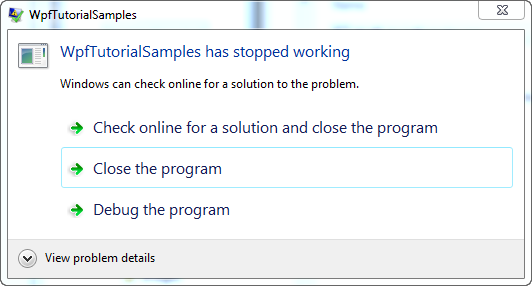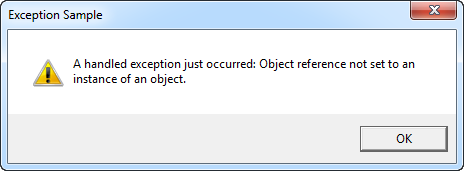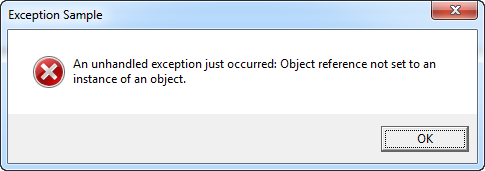This article is currently in the process of being translated into Tamil (~91% done).
Handling exceptions in WPF
நீங்கள் exception handling ஐ c # இல் உபயோக படுத்தி இருப்பிர்கள். அதனால் இது புதிது அல்ல உங்கள் code சிலநேரம் exceptions குடுக்கும், அப்பொழுது நீங்கள் try catch இல் போடுவீர்கள் அதே போல் தான் இங்கும்
private void Button_Click(object sender, RoutedEventArgs e)
{
string s = null;
s.Trim();
}இங்கு null string ஐ நீங்கள் Trim () செய்ய முடியாது அது exception ஐ குடுக்கும் உங்களின் code try கேட்ச் இல் இல்லை என்றால் பெரிய பிரச்னை ஆகிவிடும். அதனால் சில நேரம் விண்டோஸ் அப்ப்ளிகேஷன் பாதிக்கும் இது நல்ல பழக்கம் அல்ல

இப்பொழுது நீங்கள் இந்த exception ஆல் உங்கள் அப்ப்ளிகேஷன் ஐ கிளோஸ் செய்ய நேரிடும். அதனால் உங்களுக்கு exception வரும் என்று சந்தேகம் இருந்தால் நீங்கள் கண்டிப்பாக ட்ரை-கேட்ச் உபயோக படுத்த வேண்டும் கீழ் உள்ளது போல
private void Button_Click(object sender, RoutedEventArgs e)
{
string s = null;
try
{
s.Trim();
}
catch(Exception ex)
{
MessageBox.Show("A handled exception just occurred: " + ex.Message, "Exception Sample", MessageBoxButton.OK, MessageBoxImage.Warning);
}
}இப்பொழுது நீங்கள் இந்த exception ஆல் உங்கள் அப்ப்ளிகேஷன் ஐ கிளோஸ் செய்ய நேரிடும். அதனால் உங்களுக்கு exception வரும் என்று சந்தேகம் இருந்தால் நீங்கள் கண்டிப்பாக ட்ரை-கேட்ச் உபயோக படுத்த வேண்டும் கீழ் உள்ளது போல சில நேரம் சிறிய code உங்களை பாதிக்கும் எல்லாவற்றிகும் நீங்கள் ட்ரை-கேட்ச் போட முடியாது அதனால் wpf உங்களுக்கு DispatcherUnhandledException கொடுக்கிறது. நீங்கள் இதை உபயோக படுத்தினால் உங்கள் exception இது கைப்பற்றும். கீழே உள்ளதை பார்க்கவும்
<Window x:Class="WpfTutorialSamples.WPF_Application.ExceptionHandlingSample"
xmlns="http://schemas.microsoft.com/winfx/2006/xaml/presentation"
xmlns:x="http://schemas.microsoft.com/winfx/2006/xaml"
Title="ExceptionHandlingSample" Height="200" Width="200">
<Grid>
<Button HorizontalAlignment="Center" VerticalAlignment="Center" Click="Button_Click">
Do something bad!
</Button>
</Grid>
</Window>using System;
using System.Windows;
namespace WpfTutorialSamples.WPF_Application
{
public partial class ExceptionHandlingSample : Window
{
public ExceptionHandlingSample()
{
InitializeComponent();
}
private void Button_Click(object sender, RoutedEventArgs e)
{
string s = null;
try
{
s.Trim();
}
catch(Exception ex)
{
MessageBox.Show("A handled exception just occurred: " + ex.Message, "Exception Sample", MessageBoxButton.OK, MessageBoxImage.Warning);
}
s.Trim();
}
}
}இப்பொழுது நீங்கள் இந்த exception DispatcherUnhandledException ஆல் கைப்பற்ற பட்டது ஆனாலும் trim ட்ரை-கேட்ச் வெளியில் உள்ளது அதற்கு app .xaml ஐ உபயோக படுத்தலாம்
<Application x:Class="WpfTutorialSamples.App"
xmlns="http://schemas.microsoft.com/winfx/2006/xaml/presentation"
xmlns:x="http://schemas.microsoft.com/winfx/2006/xaml"
DispatcherUnhandledException="Application_DispatcherUnhandledException"
StartupUri="WPF Application/ExceptionHandlingSample.xaml">
<Application.Resources>
</Application.Resources>
</Application>using System;
using System.Windows;
namespace WpfTutorialSamples
{
public partial class App : Application
{
private void Application_DispatcherUnhandledException(object sender, System.Windows.Threading.DispatcherUnhandledExceptionEventArgs e)
{
MessageBox.Show("An unhandled exception just occurred: " + e.Exception.Message, "Exception Sample", MessageBoxButton.OK, MessageBoxImage.Error);
e.Handled = true;
}
}
}

நாம் exception ஐ கேட்ச் செய்தோம் அனால் இம்முறை வேறு விதமாக கேட்ச் செய்தோம் இங்கு நான் e .handled ஐ true என வைத்திருக்கிறேன். இதன் மூலம் wpf நமக்கு exception handling ஐ நன்றாய் பயன்படுத்துகிறது
முடிவுரை
exception handling நமக்கு முக்கியமானது அவசியமானது .net மற்றும் wpf அதை எளிது ஆக்குகிறது. நாம் எஸ்ஸ்ப்டின் ஐ லோக்கல் ஆகவும் குளோபல் ஆகவும் உபயோக படுத்தலாம். இன்னும் சோலா போனால் நாம் அதை சீராக பயன்படுத்த வேண்டும்